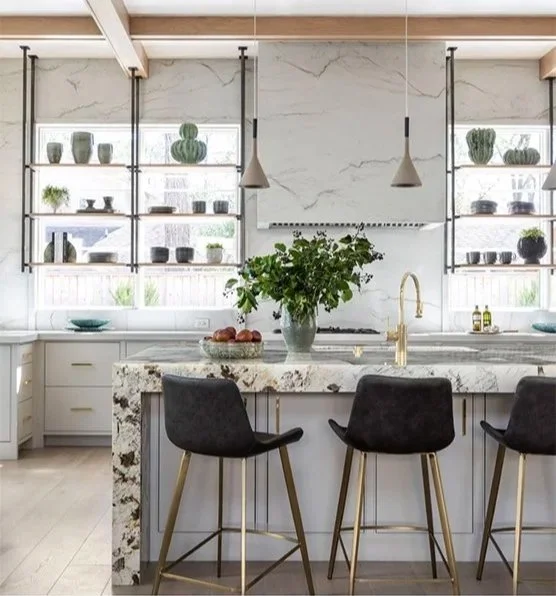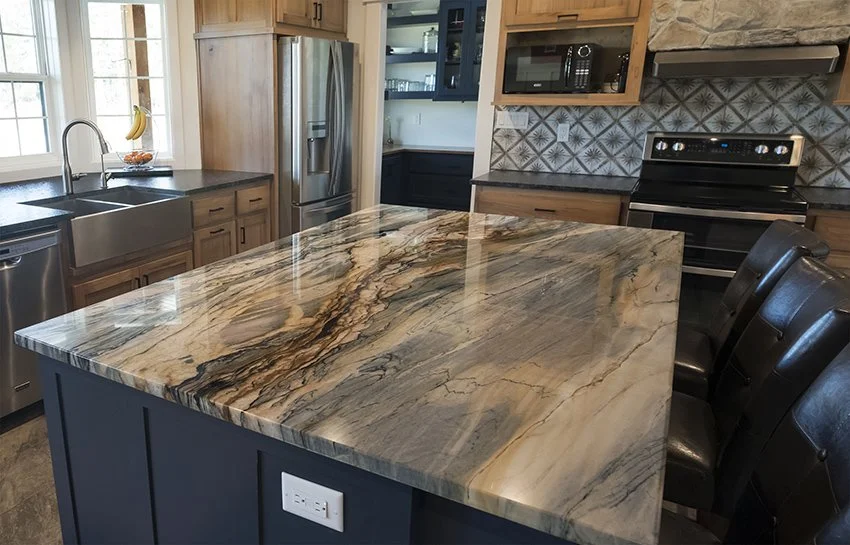HAVE YOU EVER been plopped down in the middle of a strange city with no idea of how to get where you needed to go? For many people, designing a kitchen is just as disorienting. Where do you even start?
If you are navigating a remodel or new build, here are three steps that will help you plot a course to a beautiful kitchen:
A beautiful design includes practical considerations like lighting, as the Homes and Gardens kitchen above illustrates. Photo by Benjamin Johnston Design
Choose a Style Destination
Why do designer kitchens look so coordinated? Because professionals design with a plan. They know where they’re going and they have a map and a route to get there. You can do the same.
First, choose your destination — the kitchen style. An easy way to get started is to make a list of words that best describe your dream kitchen. Adjectives like cozy, sophisticated, bright, elegant, contemporary, soothing, colorful, etc. will help define the look you want. Then search kitchen images that match those words and browse sites like houzz, pinterest, and Elle Decor to formulate your style.
Certain styles are often associated with specific color palettes, like this traditional kitchen featured by Better Homes & Gardens. Photo by Julie Soefer.
Create a Color Roadmap
Once you have a destination in mind, it’s time to create your roadmap, the color palette. If this seems overwhelming, don’t worry — there’s an app for that. This list of color palette generators from thespruce.com can get you started.
A room palette usually consists of one to two primary colors and two to five complementary colors. The photos below provide an example:
Photos by WilgusIQ in Springfield, Missouri.
In the kitchen shown here, soft white cabinets are accented by various shades of grey from the tile to the island. Black granite countertops frame the room like a piece of art, while the dark chocolate floors help make the cabinets pop. Bright flowers, cookware, and decor provide the color.
As with many design palettes, this one makes extensive use of neutral colors. “When you follow a neutral color palette,” observes Decorating Den, “you give yourself the flexibility to change your mind. You’re not stuck with a color scheme that you can’t easily alter, and you can experiment with different styles and trends.”
Once you have your style destination and color roadmap set, you’ll want to choose the route that will get you to your dream kitchen as efficiently as possible.
“Matching colors, cabinetry, and fixtures might feel like an easy route to take when designing your kitchen,” says Wendy Rose Gould on marthastewart.com, “but try embracing contrast in both color and texture.” Photo by Claire Flannery / Period Media
Take the Best Route
To help you avoid wasting time and money, design the kitchen in the right order. What is the best sequence for your design decisions?
Most experts agree, decide on cabinets first. Cabinets usually represent the most surface space in a kitchen. They also anchor your style and color scheme, so it usually makes sense to choose them first.
Choosing whether to paint your cabinets or use a natural wood stain is a critical first step that will help determine the style and color palette of your kitchen. Photo by WilgusIQ.
Next on your route, choose the countertops. Be sure to bring along wood and color samples to compare with possible countertop materials. You’ll want to remember when looking at slabs with the same color name that, while quartz, porcelain, sintered stone, and other engineered products are uniform in color, natural stone and marble can vary quite a bit between slabs. If you happen to fall in love with a unique set of granite, quartzite, or other natural stone slabs that don’t synch perfectly with your palette, it’s still early enough to adjust colors.
One Missouri couple travelled hundreds of miles to find the perfect Louise Blue quartzite slab to serve as the centerpiece of their kitchen. Photo by WilgusIQ.
Now is also a good time to consider how the countertops’ finish and edges can complement your chosen style.
Your next decision, backsplash, should tie the cabinets and countertops together with a little “wow” factor of its own. It can be a full-height extension of your countertop material or it could be ceramic tile, wood, glass, metal — really, the sky’s the limit!
As House Beautiful says, “A little pattern goes a long way.” These custom-designed backsplash tiles give the kitchen its “wow” factor. Photo by Carmel Brantley.
Fourth step: flooring. Resist the urge to match the flooring with another kitchen element, unless you are making a special design statement. “Contrast can be a designer’s best tool in setting the tone of a room,” notes Floor and Home. “Dark cabinets with lighter floors can make a room feel more spacious, while light cabinets with dark floors can create a warm, inviting atmosphere.”
Finally, choose the wall color last. “Paint,” observes Chism Brothers Painting, “is a lot easier to change than countertops or cabinets.” You may even find your wall color preferences evolving after seeing the foundation elements and secondary items like hardware, sink, and decor all together.
Finding your way around a kitchen design is easier when you have a destination, map, and route in mind, and WilgusIQ is happy to help you on your journey. Our website and sales staff can support you in choosing cabinets and countertops that match your lifestyle and color palette. Please contact us for more information or showroom hours.








